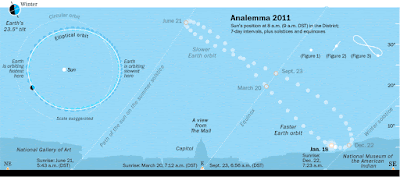“‘Tis the season to be jolly…” It was easy enough to note the shortest day as the longest night. But the earliest sunset and latest sunrise are several days different from the solstice. In fact, it makes sense to celebrate the Winter Solstice Season (“Christmas”) from December 8 (“St. Nicholas Day”) to January 4 (no best feast day there). On the other side of the year, Summer Solstice would be from June 10 to July 1, call it Flag Day to Independence Day on the civil calendar.
Our New Year comes from Rome during the dictatorship of Gaius Julius Caesar. As farmers, the old Romans had started their year in March.The two winter months had no names. They were dead times. It is why we still call the ninth month by the name of the seventh: “September.” Julius Caesar courted Cleopatra Ptolemy and sought to unite Rome and Egypt. He moved New Year’s Day to January 1.
 |
| Dates and Times of Earliest Sunsets (EarthSky dot com here.) |
“In this paper the question of prediction of the Nile flood based on the first morning visibility of Sirius is considered. It is shown that the only text that describes this event is formulated very vaguely. It makes impossible to derive a reliable astronomical dating. Modern interpretations of this text are based on the free interpretation of the original source, and often do not match. According to historical evidence of Greek authors and later Egyptian texts, flooding of the Nile based on heliacal rising of Sirius could be predicted at the beginning of [the first] millennium AD. This fact is confirmed by astronomical calculations.” (From “Heliacal rising of Sirius and flooding of the Nile” by Nickiforov, M. G. and Petrova, A. A. in Bulgarian Astronomical Journal, Vol. 18, No. 3, p. 53 archived at the Astrophysics Database at Harvard here.)
For the Celts, New Year’s was harvest time, Samhain, what we call Halloween. In some places in medieval Europe, New Year's Day was May Day. During a warming period, New Year's Day became the Vernal Equinox: the first day of spring. Easter is still tied to Passover: the first Sunday after the first full moon after the first day of Spring. Those who kept the old calendar were “April Fools.” Correlating the lunar and solar calendars and marking those over centuries gave rise to modern astronomy. In any case, it was Julius Caesar who made January 1 New Year’s Day. It marked the close of the Saturnalia solstice celebrations.
Earliest sunrise latest sunset near solstice (Washington Post here)
A few years ago, I was working as a security guard and it was late March or early April. Three of us were walking a shift change about 6:00 PM. One guy was an Army brat who had lived around the world, a lot of it in Scotland. The other guy grew up here in Austin. We stepped outside. After about ten days of rain, the sky was clear. “Hey, look,” I said, “the sun is still up.” The guy from Austin was taken aback. “What do you mean?” he said. “The sun goes down the same time every night.” Well, in Austin, it mostly does, but not where I’m from and surely not in Scotland.
 |
Analemma 2011 from The Washington Post here. The apparent position of the Sun depends on the tilt of the Earth and the eccentricity of our orbit. |
 |
| More than you ever wanted to know at the US Naval Observatory web site here. |
PREVIOUSLY ON NECESSARY FACTS


No comments:
Post a Comment
Note: Only a member of this blog may post a comment.